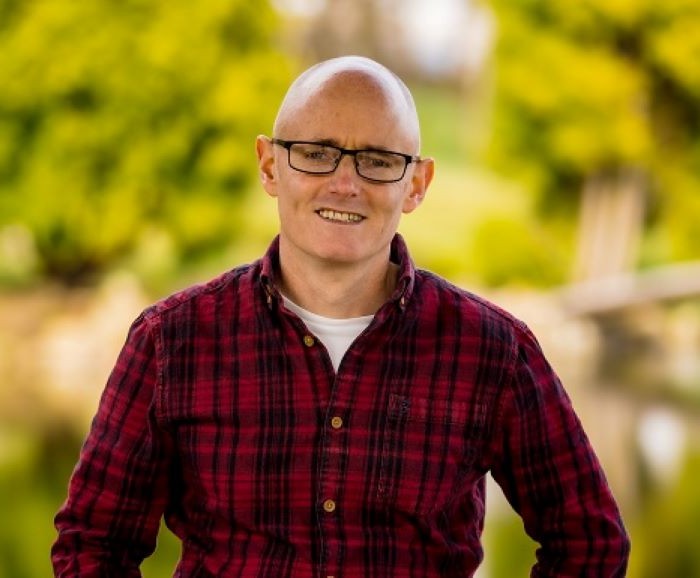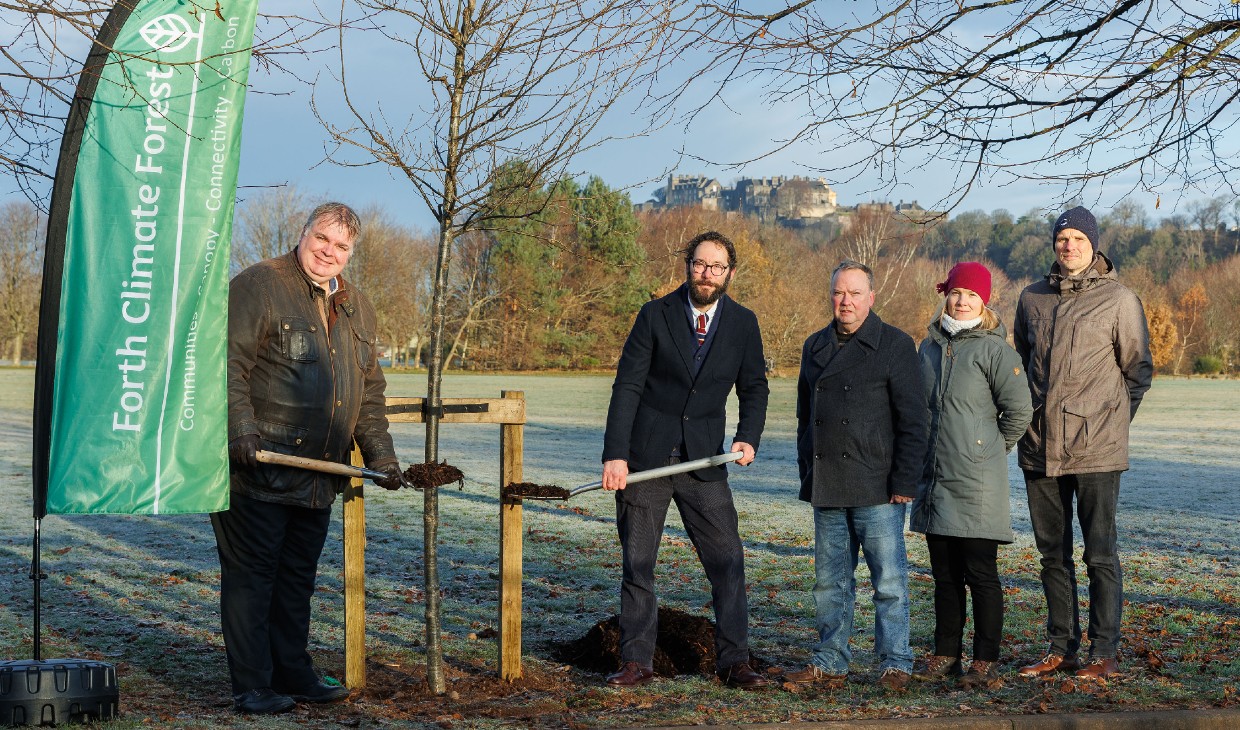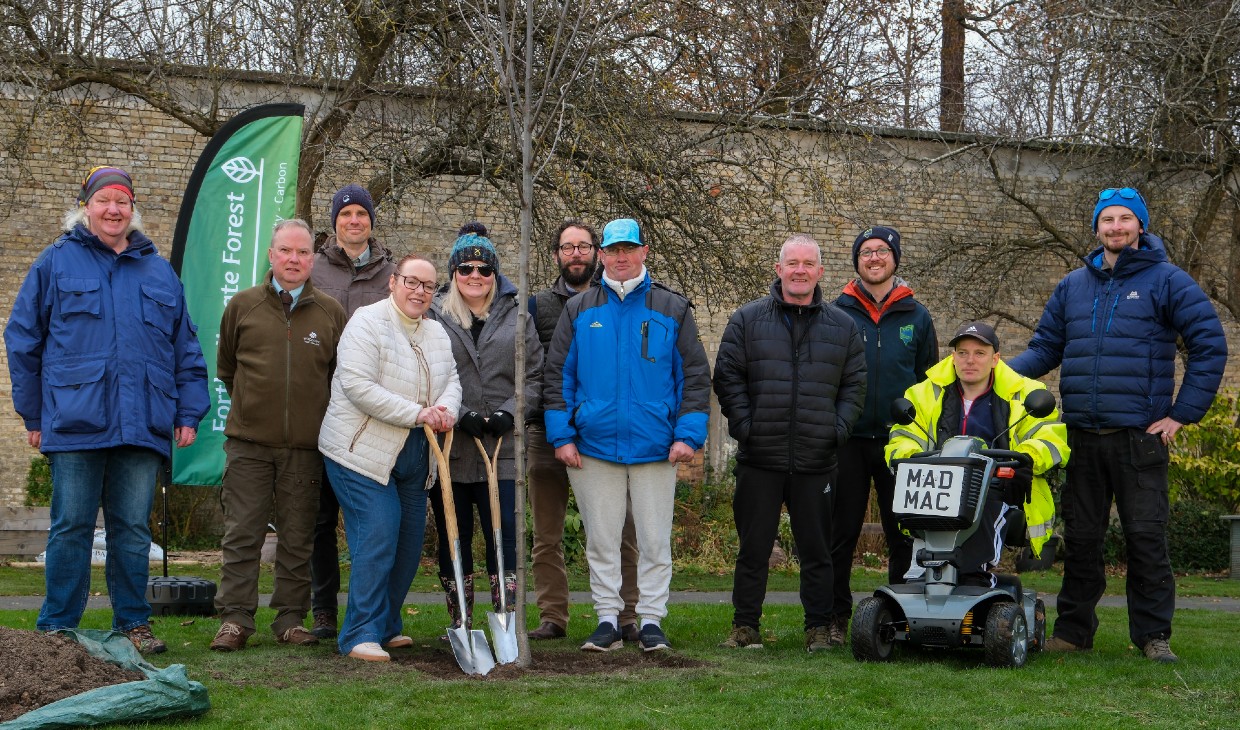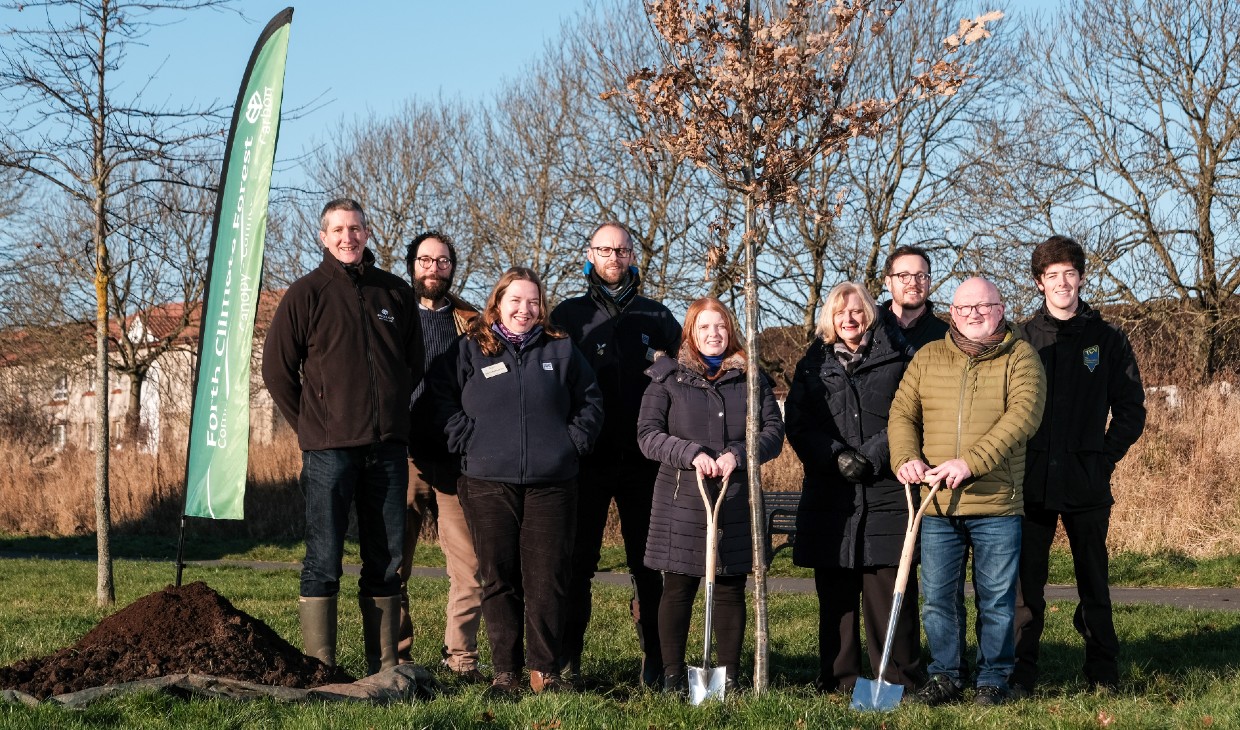A groundbreaking initiative led by the University of Stirling will see millions of trees planted across Forth Valley to tackle the twin crisis of climate change and biodiversity loss.
The Forth Climate Forest initiative will facilitate the planting of 16 million new trees to increase the woodland cover across Stirling, Clackmannanshire and Falkirk council areas.
The first trees were planted in Loch Lomond and The Trossachs National Park at Glen Finglas near Brig o’Turk on November 27. Trees were also planted by local authority leaders in Stirling, Clackmannanshire and Falkirk last week.
The new trees will help prevent the extremes of flooding and temperatures, purify our air and absorb carbon from the atmosphere, delivering long-term ecological, climate and social benefits.

Dean of the Faculty of Natural Sciences at the University of Stirling
Nature-based solutions such as the Forth Climate Forest will bring major benefits for people, biodiversity and management of climate change impacts alongside speeding the region's journey to a low-carbon future. The planting of the first trees is an important step on that journey.
The tree planting events were held in National Tree Week, the UK’s largest annual tree celebration which sees the country’s conservation sector, volunteer groups and tree-lovers come together to plant thousands of trees to mark the start of the tree planting season.
Stirling Council Leader, Councillor Chris Kane, said: “This major tree-planting project will boost the amount of carbon we capture and help achieve our net zero targets for the region, as well as protecting and enhancing our stunning natural environment for future generations.”
 (l-r) Councillor Chris Kane, Stirling Council Leader; Douglas Worrall, Director of Forth Climate Forest, University of Stirling; Peter Lowe, Woodland Trust Scotland; Dr Sandra Engstrom, Forth Climate Forest, University of Stirling; Guy Harewood, Forth Climate Forest Development Officer, University of Stirling.
(l-r) Councillor Chris Kane, Stirling Council Leader; Douglas Worrall, Director of Forth Climate Forest, University of Stirling; Peter Lowe, Woodland Trust Scotland; Dr Sandra Engstrom, Forth Climate Forest, University of Stirling; Guy Harewood, Forth Climate Forest Development Officer, University of Stirling.
Clackmannanshire Council Leader, Councillor Ellen Forson, said: “Not only will the planting of these new trees help with our efforts in tackling climate change, it will also boost biodiversity, and could potentially lead to some social benefits for our residents in the longer term.”
 (l-r) Eric Armour, Wimpy Park Community Group; Peter Lowe, Woodland Trust Scotland; Guy Harewood, Forth Climate Forest Development Officer, University of Stirling; Councillor Ellen Forson, Clackmannanshire Council Leader; Councillor Fiona Law; Douglas Worrall, Director of Forth Climate Forest, University of Stirling; Scott Mitchell, Wimpy Park Community Group; Finn Robertson, Wimpy Park Community Group; Josh Thornhill, The Conservation Volunteers; John Macaloney, Wimpy Park Community Group; Ross Brae, Clackmannanshire Council.
(l-r) Eric Armour, Wimpy Park Community Group; Peter Lowe, Woodland Trust Scotland; Guy Harewood, Forth Climate Forest Development Officer, University of Stirling; Councillor Ellen Forson, Clackmannanshire Council Leader; Councillor Fiona Law; Douglas Worrall, Director of Forth Climate Forest, University of Stirling; Scott Mitchell, Wimpy Park Community Group; Finn Robertson, Wimpy Park Community Group; Josh Thornhill, The Conservation Volunteers; John Macaloney, Wimpy Park Community Group; Ross Brae, Clackmannanshire Council.
Falkirk Council Leader, Councillor Cecil Meiklejohn, said: “Communities will benefit once these corridors are created with them improving the environment, boosting biodiversity and providing more attractive areas for everyone to enjoy.”
 (l-r) Alistair Seaman, Woodland Trust Scotland; Douglas Worrall, Director of Forth Climate Forest, University of Stirling; Alice MacPherson, RSPB; James Stead, RSPB; Claire Gibson, Energy and Climate Change Coordinator, Falkirk Council; Councillor Cecil Meiklejohn, Falkirk Council Leader; Josh Thornhill, The Conservation Volunteers; William Martin, Friends of Rannoch Park; Gregor McLeod, The Conservation Volunteers.
(l-r) Alistair Seaman, Woodland Trust Scotland; Douglas Worrall, Director of Forth Climate Forest, University of Stirling; Alice MacPherson, RSPB; James Stead, RSPB; Claire Gibson, Energy and Climate Change Coordinator, Falkirk Council; Councillor Cecil Meiklejohn, Falkirk Council Leader; Josh Thornhill, The Conservation Volunteers; William Martin, Friends of Rannoch Park; Gregor McLeod, The Conservation Volunteers.
Forth Climate Forest will work with local people, community groups, land managers, businesses, environmental charities and public agencies to plant more trees where they are needed the most.
Trees will be planted in school grounds, on vacant and derelict land and across parks. Where possible, existing woodlands will be stitched together to create wildlife corridors that boost biodiversity, offering a safe habitat for birds, bats, bees and all manner of woodland animals.
Everyone can get involved
Director of Forth Climate Forest, Doug Worrall, said: “The Forth Climate Forest is a new, ambitious, tree planting initiative for the Forth Valley Area. Over the next 10 years we aim to plant 16 million trees across Stirling, Clackmannanshire and Falkirk Council areas to help tackle the twin crisis of climate change and biodiversity loss.
“We want to plant these 16 million trees where they are needed most, so that neighbourhoods can cope with extreme weather events, so that there is a network of connected woodlands where wildlife can thrive, and so that we are on track to achieve net zero targets.
“The great thing about tree planting is that everyone can get involved, meaning that everyone can do something positive to fight climate change and help stop the decline of our wildlife.”
Forth Climate Forest is part of Scotland’s International Environment Centre at the University of Stirling, a pioneering collaboration that will create an innovation community in Forth Valley, driving the creation of a net zero regional economy and acting as a global exemplar of low-carbon growth.
World-class exemplar
Dean of the Faculty of Natural Sciences at the University of Stirling, Professor Alistair Jump, said: “Scotland's International Environment Centre is building a world-class exemplar of a regional transition to net zero ways of living. Nature-based solutions such as the Forth Climate Forest will bring major benefits for people, biodiversity and management of climate change impacts alongside speeding the region's journey to a low-carbon future.
“The planting of the first trees is an important step on that journey, and we look forward to seeing this exciting project make a difference to communities throughout Forth Valley.”
The Forth Climate Forest covers Clackmannanshire, Falkirk and Stirling Councils, as well as a large part of Loch Lomond and The Trossachs National Park.
Forth Climate Forest is a partnership initiative, hosted by University of Stirling through Scotland’s International Environment Centre.
Funding has been secured, for the first two years, from the Woodland Trust Scotland, Scottish Forestry, Clackmannanshire Council, Falkirk Council and Stirling Council.
More information about the initiative can be found at the University of Stirling website.

-UoS-Glen-Finglas-Tree-Planting-02-1920-x-689.jpg)